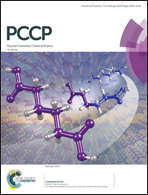A photoelectron spectroscopy and quantum chemical study on ternary Al–B–O clusters: AlnBO2− and AlnBO2 (n = 2, 3)†
Abstract
Both B and Al have high oxygen affinity and their oxidation processes are highly exothermic, hinting at intriguing physical chemistry in ternary Al–B–O clusters. We report a combined photoelectron spectroscopy and density-functional study on the structural, electronic, and bonding properties of AlnBO2− and AlnBO2 (n = 2, 3) clusters. Ground-state vertical detachment energies (VDEs) are measured to be 2.83 and 2.24 eV for Al2BO2− and Al3BO2−, respectively. A weak isomer is also observed for Al3BO2− with a VDE of 1.31 eV. Coalescence-kick global searches allow the identification of candidate structures, confirmed via comparisons with experiment. The Al2BO2− anion is V-shaped in geometry, Cs (1A′), with an Al center connecting to OB and OAl terminals. It can be viewed alternatively as the fusion of BOAl and AlOAl by sharing an Al atom. Al3BO2− has a Cs (2A′′) global minimum in which an Al2 dimer interacts with bridging boronyl (BO) and an OAl unit, as well as a low-lying C2v (2B2) isomer consisting of boronyl and OAl that are doubly bridged by two Al atoms. The BO2 block (linear O![[double bond, length as m-dash]](https://www.rsc.org/images/entities/char_e001.gif) B
B![[double bond, length as m-dash]](https://www.rsc.org/images/entities/char_e001.gif) O chain) is nonexistent in any of the anion and neutral species. Chemical bonding in these Al–B–O clusters is elucidated via canonical molecular orbitals and adaptive natural density partitioning. The cluster structures are also rationalized using the concept of sequential and competitive oxidation of B versus Al centers in AlnB. The first O atom prefers to oxidize B and form BO, whereas the second O atom has options to interact with a fresh Al/Aln/AlnB unit or a BO group. The former route wins thermodynamically, leading to the observed geometries.
O chain) is nonexistent in any of the anion and neutral species. Chemical bonding in these Al–B–O clusters is elucidated via canonical molecular orbitals and adaptive natural density partitioning. The cluster structures are also rationalized using the concept of sequential and competitive oxidation of B versus Al centers in AlnB. The first O atom prefers to oxidize B and form BO, whereas the second O atom has options to interact with a fresh Al/Aln/AlnB unit or a BO group. The former route wins thermodynamically, leading to the observed geometries.



 Please wait while we load your content...
Please wait while we load your content...